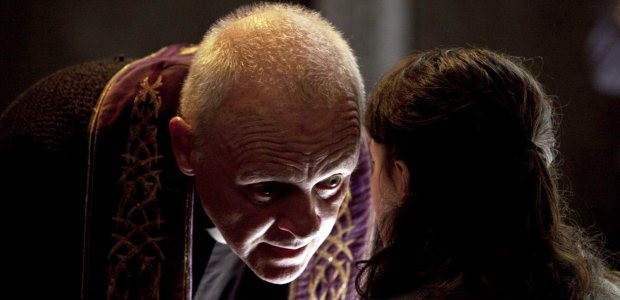You need not look any further than this, as an example of how veteran actors choose the most ridiculous movies. Coming from Anthony Hopkins, this is a classic example of how star power is under used; and for what? A plot based on actual events? What this film is actually based on, is a book written by Rome-based Matt Bagilio. The Making of a Modern Exorcist was published by Bagilio in 2009, following a Vatican recognized seminar on exorcism. At the seminar, officially known as ‘Pontifical Athenaeum Regina Apostolorum’, Bagilio met Father Gary Thomas, a parish priest skeptical over demonic possession. Herein lies my first question. Although Bagilio’s book is a non-fictional account of the skepticism of a priest, how can Father Thomas profess his faith by believing in God but not the Devil? This is as far as ‘actual events’ go.
Substituting Father Gary Thomas is Colin O’Donoghue as Michael Kovak, a mortician who study’s to be a priest, then ends up resigning due to lack of faith. However, on the day of his resignation, Michael witnesses a horrific accident and is forced to perform the rite of absolution for the dying victim (the forgiveness of sins when death is imminent). Before long, Michael is sent to Rome to study Exorcism where he is taken under the wing of Father Lucas (Anthony Hopkins), an active expert in exorcism. While witnessing Father Lucas exorcising demons out of a sixteen year-old girl, Michael’s skepticism grows, until the day he realizes that Father Lucas himself is slowly exhibiting symptoms of possession; Possession by one of the oldest and most feared demons in the history of creation.
For a debut leading role, O’Donoghue fails to impress. All his scenes are uninspiring and never really connects with the audience. By the end of it, we really don’t care if his character is a believer or not. Perhaps O’Donoghue is not entirely at fault here, given the plot he has had to work with. Bagilio also co-wrote the screenplay but seems to focus a lot on Michael Kovak’s inner demons (pun unintended) and insecurities. These are brought out by regular flash backs depicting Michael’s childhood, and clearly shows a dysfunctional relationship with his father (Rutger Hauer, in a very limited role). One particular flash back seems to suggest malevolent tendencies by his father, but this is never fully explained and so we cannot accept it as an actual event in his childhood or a fragment of his imagination. Hopkins on the other hand is brilliant as usual and emits powerful screen presence. His role however, is somehow severely underdeveloped. Again, this has more to do with the material Hopkins has had to work with, rather than any shortcomings on his part. That said, if his miscast role in The Wolfman is strike-one, his under used talents here is a worrying strike-two. For the screen legend that is Anthony Hopkins, this trend should be a writing on the wall.
Having written and directed horror movies in the past, Mikael Håfström had a potential masterpiece, even if you consider the half-baked screenplay. Unlike The Exorcism of Emily Rose, which is a horror/mystery surrounding the death of a possessed girl, The Rite has a much more broader religious undertone and also tries to induce the viewer’s perception on topics relating to faith, sin, and the often underestimated power of the devil. As a director, Håfström has failed to exploit on what could have been a fresh concept in isolating exorcism from mainstream horror as a genre. Another aspect that could have been better is the pacing. Although plot related, the pacing is rather dull and almost makes the film a drama instead of the horror movie it is intended to be. Again, and related to the plot, is the fallacy that demonic possession only occurs within Christian communities and that only Catholic priests are skilled at performing exorcisms; No doubt, this cliché is most likely a tribute to that unforgettable classic that started it all – The Exorcist (1973). Where Håfström succeeds is in maintaining an eerie atmosphere and even avoids using jumpy scenes as used in conventional scare tactics. Special effects are also sparse and used only when rendering pure evil through actor’s facial expressions. As such, don’t expect any head spinning, spewing of pea soup, levitation or crawling on the walls.
For what it’s worth, The Rite could have been much more than what it is. It could have been a lot more scary, or disturbing, or profound by asking questions that has the potential to shake the foundations of theology. Instead, all we get is almost two hours of a drama where one priest questions his faith while another loses it.
Rating: 




